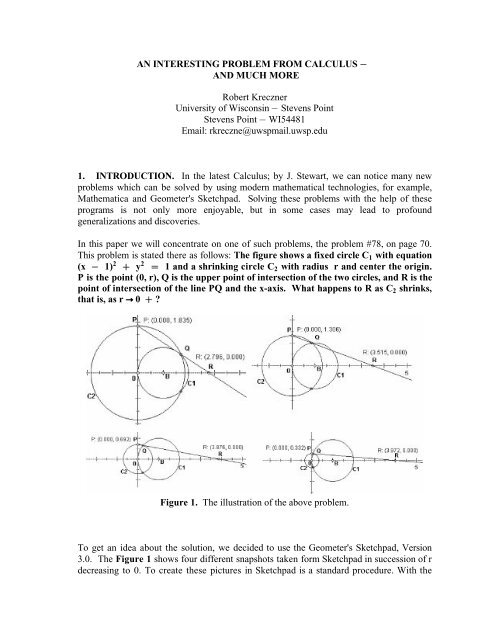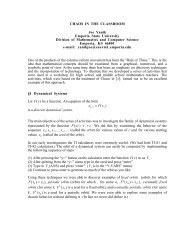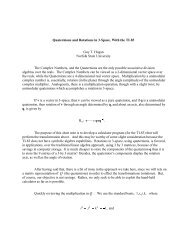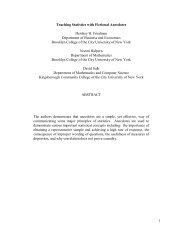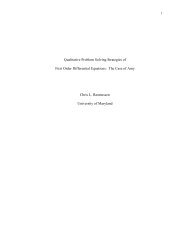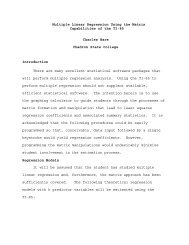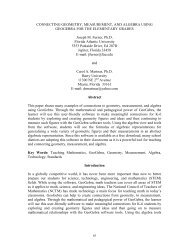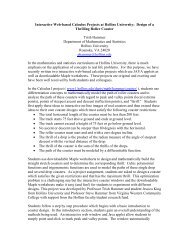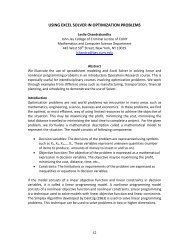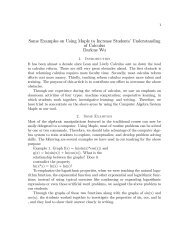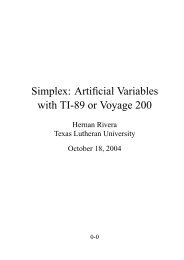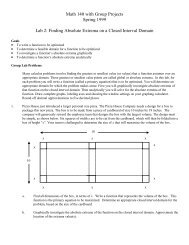paper (pdf) - Mathematics Archives
paper (pdf) - Mathematics Archives
paper (pdf) - Mathematics Archives
You also want an ePaper? Increase the reach of your titles
YUMPU automatically turns print PDFs into web optimized ePapers that Google loves.
AN INTERESTING PROBLEM FROM CALCULUS<br />
AND MUCH MORE<br />
Robert Kreczner<br />
University of Wisconsin Stevens Point<br />
Stevens Point WI54481<br />
Email: rkreczne@uwspmail.uwsp.edu<br />
1. INTRODUCTION. In the latest Calculus; by J. Stewart, we can notice many new<br />
problems which can be solved by using modern mathematical technologies, for example,<br />
Mathematica and Geometer's Sketchpad. Solving these problems with the help of these<br />
programs is not only more enjoyable, but in some cases may lead to profound<br />
generalizations and discoveries.<br />
In this <strong>paper</strong> we will concentrate on one of such problems, the problem #78, on page 70.<br />
This problem is stated there as follows: The figure shows a fixed circle C 1 with equation<br />
2 2<br />
(x 1) € y œ<br />
1 and a shrinking circle C 2 with radius r and center the origin.<br />
P is the point (0, r), Q is the upper point of intersection of the two circles, and R is the<br />
point of intersection of the line PQ and the x-axis. What happens to R as C 2 shrinks,<br />
that is, as r p 0 €<br />
<br />
Figure 1. The illustration of the above problem.<br />
To get an idea about the solution, we decided to use the Geometer's Sketchpad, Version<br />
3.0. The Figure 1 shows four different snapshots taken form Sketchpad in succession of r<br />
decreasing to 0. To create these pictures in Sketchpad is a standard procedure. With the
Sketchpad, we can keep shrinking continuously the circle C 2 by dragging with mouse the<br />
point P towards origin, and at the same time observing that the point R approaches the<br />
number 4. Furthermore, by taking advantage that the drawings in the Sketchpad are<br />
dynamic, we can easily change the circle C 1 to a circle of any radius r, and make an<br />
observation that the point R approaches the number 4 † r.<br />
A similar exercise can be carry out for the problem in which the circle C 1 is<br />
replaced be a straight line with positive slope passing through origin. This time we will<br />
observe that the point R approaches 0.<br />
2. GENERALIZATION. The described above problem can be easily generalized by<br />
replacing the fixed circle C1 by any curve. In the Figure 2 below, this curve is denoted<br />
again by C 1 . Since we are going to shrink the circle C 2 , the only important part of the<br />
curve is the part that is immediately close to origin. Therefore, naturally we can assume<br />
that the curve C 1 passes through the origin, is smooth enough; and for positive x close to<br />
origin, it lies in the first quadrant, and is increasing there.<br />
Figure 2.<br />
Thus our problem, with these assumptions, is to find limit of the point R as radius r of<br />
circle C approaches 0<br />
2 .<br />
3. SETTING UP FOR GENERAL SOLUTION. In this paragraph, We will refer to the<br />
notation of the Figure 2. If the curve C 1 is given by an equation F(x, y) œ 0, then the<br />
coordinates of the point Q œ (x, y), the point of intersection of the circle C 2 and the<br />
curve C 1, can be found by solving system of equations,<br />
2 2 2<br />
F(x, y) œ 0 and x € y œ r (3.1)
Then, the equation of the line through the points P and Q is<br />
Y r X . (3.2)<br />
x<br />
Setting Y œ 0 in the equation (3.2), we get the x-coordinate of the point R,<br />
Thus, our problem is to find<br />
œ Y r<br />
rx<br />
y r<br />
X œ . (3.3)<br />
rx<br />
lim , (3.4)<br />
y r<br />
rp0+<br />
which we denote by limtR.<br />
However, this problem as simple as it might seem at the first sight, to carry out this<br />
computation, even for simple equations F(x, y) œ 0, is very laborious and tedious, or<br />
even impossible to do especially for most students. There are three main reasons for these,<br />
the system of equations (3.1) is to difficult or impossible to solve, the expression (3.3) is<br />
lengthy, and thus the computation of limit (3.4) is not clear. In contrast, with the<br />
Mathematica all these difficulties might be avoided, especially if the equation F(x,y) œ 0 is<br />
relatively simple. In this <strong>paper</strong> we decided restrict ourselves to the cases when the equation<br />
F(x,y) œ 0 represents conics. We also must remember that our goal is not to do the<br />
computations, but make a discovery.<br />
4. MATHEMATICA IN ACTION. We will apply the Mathematica to do all the<br />
computations described in the paragraph 3. To do these we can use the following program.<br />
# # #<br />
pointQ:=Solve[{x € y œ =r , F(x,y) œ<br />
=0}, {(x, y}]<br />
pointR:=(r*x)/(r<br />
y)/. {pointQ[[4]][[1]], pointQ[[4]][2]]}<br />
limitR= Limit[ pointR, r >0}<br />
Warning: For some reason, if the equation F(x,y) œ 0 have a parameter, the Limit<br />
command produces incorrect output. For example, for parabola given by equation y<br />
# œ 2 a<br />
x, the output is 0, which is incorrect. However, if we define the parameter a to be the<br />
number E or Pi, the Limit is computed correctly, and at the same time we can see the<br />
answer in general form since E and Pi being transcendental numbers will not cancel out<br />
during symbolic computation. Thus, in the above program we can line a: œ Pi, and so on.<br />
The intermediate results of this computation we will illustrate for parabola<br />
y # œ 2ax only, the final results for the other curves are included in Table 1, the middle<br />
column.
In[1]:=<br />
PointQ=Solve[{x^2 € y^2==r^2, y^2==2 a x},{x,y}]<br />
Out[1]=<br />
# % # #<br />
2 a 2 Sqrt[a € a r ]<br />
# % # #<br />
2 a<br />
{{x > , y > Sqrt[ 2 a 2 Sqrt[a € a r ]},<br />
# % # #<br />
2 a 2 Sqrt[a € a r ]<br />
# % # #<br />
2 a<br />
{x > , y > Sqrt[ 2 a 2 Sqrt[a € a r ]},<br />
# % # #<br />
2 a € 2 Sqrt[a € a r ]<br />
# % # #<br />
2 a<br />
{x > , y > Sqrt[ 2 a € 2 Sqrt[a € a r ]},<br />
# % # #<br />
2 a +2 Sqrt[a € a r ]<br />
# % # #<br />
2 a<br />
{x > , y > Sqrt[ 2 a € 2 Sqrt[a € a r ]}}<br />
In[2]:=<br />
pointR=(r x)/(r<br />
y)/ { pointQ[[4]][[1]], pointQ[[4]][[2]]}<br />
†<br />
Out[3]=<br />
# % # #<br />
r( 2 a € 2 Sqrt[a € a r ])<br />
2a (r Sqrt[ 2 a# € 2 Sqrt[a% € a<br />
#<br />
r<br />
#]])<br />
In[4]:=<br />
a:=Pi<br />
In[5]:=<br />
limitR=Limit[pointR, r >0]<br />
Out[5]=<br />
4 Pi<br />
5. LITTLE DISCUSSION. Before we show the results of our computation, we would<br />
like to discuss the possible solutions. Our first guess is that limit of R depends on the<br />
tangent line to the curve C 1 at origin. However, this assertion has to be rejected since for<br />
any line passing through the origin the point R tends to the origin. The second guess is that<br />
this limit should depend on the curvature of curve C 1 at origin, since the curvature fully
characterizes a curve. Keeping these remarks in our mind, the analysis of the Table 1<br />
should bring the desired discovery<br />
Figure 3. Illustration of the main Theorem.<br />
Curve Limit of R Curvature at Origin<br />
Line y œ ax 0 0<br />
Circle (x<br />
2 2<br />
r) € y œ<br />
2<br />
r 4r<br />
1<br />
r<br />
(x<br />
2<br />
a)<br />
2<br />
y<br />
2<br />
4b a<br />
a2 b2 a b<br />
2<br />
2<br />
(x € a)<br />
2<br />
y<br />
2<br />
4b a<br />
a<br />
2<br />
b<br />
2<br />
a b<br />
2<br />
2 2 2 2 1<br />
a € b<br />
Ellipse € œ 1<br />
Hyperbola œ 1<br />
Circle (x a) € (y b) œ a € b 0<br />
È<br />
Table 1.<br />
6. MAIN DISCOVERY. Under the assumptions of Paragraph 2, observations made out<br />
of the Table 1, and notations of Figure 3, we can state the following<br />
THEOREM. If the curvature circle C 3 of a curve C 1 at origin has radius 3and its center<br />
lies on x-axis, then the point R approaches number 4 3. Otherwise, the point R approaches<br />
origin.<br />
Proof. We will give only the proof for the case when the center of curvature lies on x-<br />
axis, this is illustrated by Figure 3. For the other case the proof is the same.<br />
Let % ž 0 be any real number, and C 4 be the circle with radius 3 € % and center<br />
( 3 € %, 0). The points S and T are the x-intercepts of the lines passing through the point P<br />
and the intersection points of the circle C 2 with the circles C 3 and C 4, respectively. Then,<br />
since we assumed that the curve C1is concave down in the first quadrant, close to origin,<br />
we observe that the point R is between the points S and T. From the Table 1, we know that<br />
S and T tend to 43 and 4( 3 € %) respectively, as r >0 . Therefore, limit of R is also<br />
between 43and 4( 3 € %). Since % is any real positive number, limit of R must be 43.<br />
2 2
REFERENCES<br />
1. James Stewart, Calculus; Early Transcendentals, 3rd edition, Brooks/Cole, 1994.


